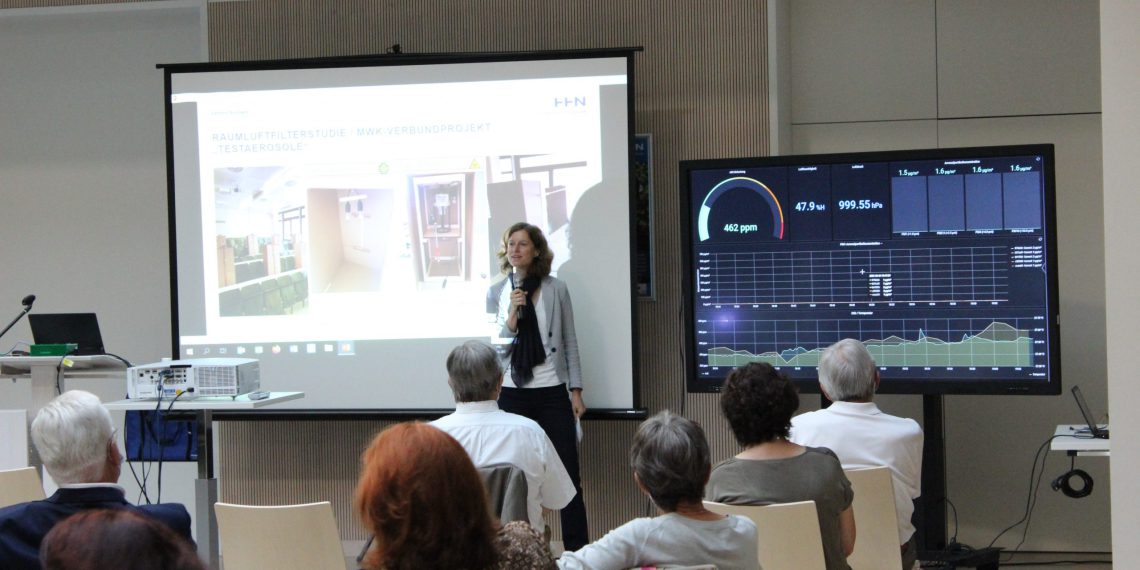When using a room air filter from MANN+HUMMEL, Heilbronn University (HHN) demonstrates a reduction in aerosol particle concentration of up to 90% with the recommended setting and best possible installation. The research team led by Professor Jennifer Niessner and Prof. Dr. Raoul Zöllner investigated the relative risk of infection explicitly at the points where students inhale, relying on a low-cost sensor network and flow simulations.
Indoor air purifiers are controversial as a means of containing the SARS-CoV2 pandemic for schools and universities. One of the main routes of transmission for SARS-CoV‑2 viruses are tiny airborne droplets called “aerosols” that are emitted when people breathe, talk, sneeze, cough, and sing. Mobile room air filters aim to reduce the indirect risk of infection by removing aerosol particles. However, it has not yet been clear what role the position and orientation of a room air filter has, whether these devices always lead to a similar reduction in infection risk at all positions, or possibly increase it locally in special cases.
HHN Professor Niessner and her team investigated the effectiveness of the OurAir SQ 2500 room air filter, which was provided by MANN+HUMMEL. The occupied seats in the test lecture hall, the location of the “infected”, the installation location and the orientation of the room air cleaner as well as the volume flow of the room air cleaner were varied and the temperature and the relative humidity were examined.
Measurements and flow simulations were used for this purpose. A period of time was considered, consisting of a combination of 20 min with a running particle generator and 20 min without particle generation. Even with an unfavorable position and orientation of the room air cleaner, the particle concentration is reduced by approx. 60 % on average. However, care must be taken to ensure that the direction of discharge does not allow particles to be transported from person to person. With a good set-up position, local reductions of up to 90% are measured in this combined scenario.
The device was set up in a step auditorium of the HHN, Campus Sontheim (room E116). Cardboard boxes with light bulbs served as dummies for people to simulate a real heating situation and a real flow obstacle. One of these dummies was equipped with an aerosol generator and emitted harmless salt spray. The team determined the aerosol particle concentration, and thus the risk of infection, using high-accuracy optical particle counters and a network of low-cost particle sensors placed in the “face” of the dummies, i.e., the locations of potential inhalation.
“The study results show that indoor air filters can help reduce the risk of infection in enclosed spaces and can be an effective component of pandemic response for schools or universities, for example.”
- Professor Jennifer Niessner
The results of the indoor air filter study are being incorporated into the collaborative research project “Test aerosols and methods for efficacy studies of air purification technologies against Sars-CoV‑2.”
Niessner is cooperating here with colleagues from the University of Stuttgart, the Karlsruhe Institute of Technology (KIT) and the University Hospital of Tübingen.
The aim of this project is to investigate the application, characterization and sampling of test aerosols, to check whether analogies from surrogate viruses to SARS-CoV‑2 are permissible and to find out how different parameters and spatial conditions influence the effectiveness of air purification devices.
Heilbronn University — Competence in Technology, Business and Computer Science
With approximately 8,200 students, Heilbronn University is one of the largest universities of applied sciences in Baden-Württemberg.
Its competence focus is on the fields of technology, business and computer science. At four locations in Heilbronn, Heilbronn-Sontheim,
Künzelsau and Schwäbisch Hall, the university offers more than 50 bachelor’s and master’s degree programs. The university maintains close cooperation with companies from the region and is thus very strongly networked in teaching, research and practice.

















